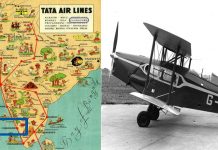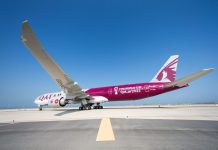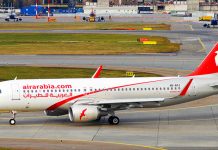10 things that happen before your plane can take off
Sitting in the terminal building waiting to be called for our flight is a regular occurrence for most of us — but what’s really going on out there on the ramp while we’re inside staring at our phones?
The jet that will carry you to your destination has likely just arrived from somewhere else. When it lands, it’ll undergo a turnaround, changing from an arriving to a departing flight.
There are vehicles and people on the ramp, ready to get your flight back in the air quickly — after all, a plane doesn’t make money sitting on the ground.
Here are the 10 steps from arrival to take-off:
1. Parking the plane

As soon as a plane lands and clears the active runway, the pilots receive taxi instructions from ground controllers. Large airports can have complex and confusing taxiway layouts, while some airports simply have a runway and a ramp area.
Approaching the terminal, the pilots look for the flight’s assigned gate and watch for the ramp team leader to start waving illuminated, bright orange batons.
There could be a lead-in lighting system to help the pilots line up at the gate, or they might just follow the instructions from the ramp lead.
As the plane slows to a stop, the target for the nose wheel is a painted line on the ramp, matching the type of aircraft. That’ll put the plane in the right spot for the passenger boarding bridge.
2. Hooking up the plane

The plane’s engines provide thrust and electrical power while in flight, but all passenger planes have a small jet engine which generates electricity when the plane is parked — an Auxiliary Power Unit, or APU.
The APU is in the tail cone, and the pilots start it up to feed power to the plane’s systems.
But an APU uses costly fuel from the jet’s tanks, so many airports provide a ground power system, or there’s a generator cart parked at the gate. Once the plane’s access panel is opened and the connection is made with a heavy-duty cable and plug, the source of power is switched, and the engines are shut down.
3. Connecting the air-con

The APU also energizes the plane’s climate control systems, hopefully keeping the cabin at a nice temperature while parked. Like ground power, some airports provide conditioned air through large-diameter flexible ducts that plug into a port on the belly of the plane.
Or you might see a truck-mounted unit doing the job, with a duct snaking to the plane. Large, wide-body aircraft need two air connections to keep the cabin comfortable.
4. De-planing

The passengers inside the plane have jumped up, and they’re waiting impatiently in the aisle to get off — right now.
If the gate is equipped, a passenger boarding bridge is positioned by the forward left-side doors.
Otherwise, truck- or cart-mounted stairs roll up, and passengers experience the excitement of walking down the stairs and onto the ramp, being able to look back at their aircraft.
Smaller regional jets and turboprops sit close to the ground, and have stairs built into the inside of the plane’s doors, with just a couple of steps to the ramp.
5. Unloading the luggage and cargo

On the right side of the plane, the ramp team has swung into action. After opening the doors to the baggage and cargo holds, a belt-loader or a pod-loader is positioned, depending on the aircraft.
“Rampie” is the industry term for airline employees who load and unload planes.
The rampie inside the belly of a single-aisle plane places each piece of luggage onto the belt, and their partner takes it off the belt and puts it into a baggage cart.
The carts head to the baggage room, and the luggage is dropped onto a conveyor, hopefully showing up on a carousel soon after you’ve arrived.
Wide-body planes carrying hundreds of passengers needed an efficient way of handling luggage and cargo, so baggage and cargo pods were developed back when jumbo jets first appeared.
Pods are filled with passengers’ bags, and handled by a purpose-built machine. One rampie can operate it, and make the pods dance on the loader’s platform or in a plane’s holds by activating powered wheels.
6. Stocking up with food

Catering trucks join the crowd outside the plane’s fuselage. Rising on a scissor lift, the truck’s box matches the height of the plane’s galley doors.
The catering crew replaces used galley carts with newly stocked ones, each cart coded for a specific location in the galleys.
To service the double-deck Airbus A380 mega-jet, catering trucks reach way up, to the upper galley doors.
7. Cleaning the toilets

Perhaps it’s not the most desirable ramp job, but somebody’s got to empty the plane’s lavatory holding tanks, and refill the fresh water system. Just like a recreational vehicle, this doesn’t happen during every stop.
Rampies position a truck- or cart-mounted tank and pump unit, and connect hoses to do the work.
8. Refueling

Like your car, a plane’s fuel tanks aren’t necessarily filled at every stop. An airline’s operations team will have figured out how much fuel is needed for each leg of a plane’s daily routing, and when to refuel.
Big tanker trucks connect to the plane’s fuel system under the wing, or a pumper truck will hook up to a fuel hydrant in the ramp, then to the jet’s tanks, and pump away.
9. Pushback

Pushback is when an aircraft is pushed backwards away from the airport gate by vehicles called tugs or tractors.
Closer to departure, an aircraft tug will park right in front of the nose wheel.
The tug might be directly attached to the plane’s nose gear with a tow bar, or could be a “wheel-lift” tug. These tugs cradle the nose gear, then lift it up before moving the plane. That gives the tug driver control over the plane’s direction during pushback.
New taxi technologies are appearing, like pilot-controlled tugs, and electric motors mounted to the plane’s landing gear. Both promise to save fuel, and reduce airport noise.
10. Boarding and take-off

The crew has finished all the pre-flight preparations, the cabin door is closed, and you’re settled into your seat. Your journey begins with a gentle push, in reverse, and you’re anticipating the adventures to come.
Make sure you wave goodbye to the rampies — they’ve worked hard to get you on your way.



















